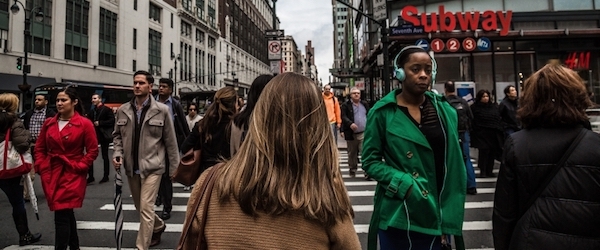Research Investigates Racially Disparate Crosswalk Interactions

Lead Researcher Kimberly Kahn appeared on Portland news channel Koin 6 in December to discuss this research.
Led by Dr. Kimberly Kahn of Portland State University, the purpose of this investigation is to explore social identity-related factors that influence drivers’ behaviors in interactions with pedestrians at crosswalks. Dr. Kahn and her research team conducted a field experiment where black and white male and female pedestrians wore identical clothing and repeatedly crossed the same intersection in a systematic manner, with coders in the field marking drivers’ behaviors.
The initial study found that black male pedestrians were passed by twice as many cars and waited nearly a third longer to cross than white male pedestrians. The second phase of the research, Racial Bias in Drivers' Yielding Behavior at Crosswalks: Understanding the Effect builds on the first study and examines how additional factors, such as gender, affect drivers’ stopping behaviors at crosswalks.
Novel findings include:
- When pedestrians were categorized by gender, female pedestrians were more likely to have the first car stop for them than male pedestrians.
- When pedestrians were categorized by race, white pedestrians more likely to have the first car stop for them than black pedestrians.
- Black men were likely to have the most cars pass them before one stopped.
- Drivers were more likely to stop with their vehicle behind the stop bar when the pedestrian was white, but after the bar when the pedestrian was black; demonstrating an intrusion into the crossing space for black pedestrians and a possible safety risk.
- At unmarked crosswalks, drivers rarely stopped for any of the pedestrians.
With a black pedestrian, cars were more likely to stop after the stop bar, infringing on the pedestrian's crossing space. With white pedestrians, the cars were leaving more of a buffer for the pedestrian to safely cross.
"We think that that has implications for pedestrian safety, and may help partially explain why we see disproportionate pedestrian fatalities based on pedestrians' race. If cars are stopping closer to black pedestrians, that could have safety implications," Kahn said.
The findings contain potential implications for safety design.
"When stopping is perceived as discretionary, rather than mandatory, that's where these types of biases are more likely to impact behavior," Kahn said.
The differences in stopping behavior may reflect implicit biases that are impacting drivers' decision making.
"It's not necessarily that drivers are consciously seeing pedestrians and saying, 'I'm not going to stop for this group compared to another.' Instead, the situation tends to reflect implicit or less conscious biases. Particularly when there's a lot of stimuli going on, in a fast-paced activity like driving with quick decisions; those are the conditions under which these subconscious, implicit biases are more likely to affect our behavior," Kahn said.
Dr. Kahn will present these findings in a NITC webinar on October 26, 2017. Read about the research in more detail in this project brief.
To get updates about this and other NITC research projects, sign up for our newsletter.
The National Institute for Transportation and Communities (NITC), one of five U.S. Department of Transportation national university transportation centers, is a program of the Transportation Research and Education Center (TREC) at Portland State University. The NITC program is a Portland State-led partnership with the University of Oregon, Oregon Institute of Technology, University of Utah and new partners University of Arizona and University of Texas at Arlington. We pursue our theme — improving mobility of people and goods to build strong communities — through research, education and technology transfer.
